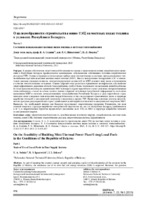О целесообразности строительства мини-ТЭЦ на местных видах топлива в условиях Республики Беларусь. Часть 1

Date
2023Publisher
Another Title
On the Feasibility of Building Mini-Thermal Power Plant Using Local Fuels in the Conditions of the Republic of Belarus. Part 1
Bibliographic entry
Седнин, В. А. О целесообразности строительства мини-ТЭЦ на местных видах топлива в условиях Республики Беларусь. Часть 1 = On the Feasibility of Building Mini-Thermal Power Plant Using Local Fuels in the Conditions of the Republic of Belarus. Part 1 / В. А. Седнин, Р. С. Игнатович, И. Л. Иокова // Наука и техника. – 2023. – № 5. – С. 418-427.
Abstract
В рамках обеспечения энергетической безопасности страны и проведения политики декарбонизации экономики в Республике Беларусь предполагается максимальное использование собственных топливно-энергетических ресурсов (ТЭР). Однако открытым остается вопрос выбора вида теплоисточника в системах централизованного теплоснабжения при использовании местных видов топлива (МВТ). Ввод в эксплуатацию Белорусской АЭС и относительно высокая удельная стоимость электрогенерирующих мощностей на МВТ склоняет чашу весов к применению в качестве теплоисточников котельных. Однако мировой опыт развития и применения теплофикации, как наиболее энергоэффективного решения в области теплоснабжения, требует более тщательного исследования данной проблемы. В статье представлен обзор по применению МВТ в Беларуси и ряде европейских стран с развитым централизованным теплоснабжением, а также на основе анализа данных открытых источников представлена информация по состоянию применения МВТ в системах централизованного теплоснабжения Республики Беларусь и ряда европейских стран, имеющих опыт в широком использовании твердой биомассы и где она составляет существенную долю в структуре выработки тепловой и электрической энергии по отношению к другим ТЭР. Приведены основные аспекты энергетических программ ряда европейских стран с наибольшей долей выработки тепловой и электрической энергии на МВТ. Выявлено, что наибольший интерес для Беларуси представляет энергетическая программа Финляндии, где доля атомной энергии в структуре выработки электрической энергии так же, как и в Республике Беларусь, приближается к 40 % и энергетическая стратегия предполагает увеличение доли ТЭЦ на МВТ в структуре выработки тепловой и электрической энергии.
Abstract in another language
As part of ensuring the country's energy security and pursuing a policy of decarbonization of the economy in the Republic of Belarus, the maximum use of its own fuel and energy resources (FER) is expected. However, the question of choosing the type of heat source in centralized heat supply systems when using local fuels (LF) remains open. The commissioning of the Belarusian Nuclear Power Plant and the relatively high specific cost of electricity generating capacities using local fuels tip the scales to the use of boiler houses as heat sources. However, world experience in the development and application of heating, as the most energy-efficient solution in the field of heat supply, requires a more thorough study of this problem. The paper presents an overview of the use of local fuels in Belarus and a number of European countries with developed centralized heat supply. Based on the analysis of open source data, the paper provides information on the state of use of local fuels in district heating systems of the Republic of Belarus and a number of European countries that have experience in the widespread use of solid biomass and where it constitutes a significant share in the structure of thermal and electrical energy production in relation to other fuel and energy resources. The main aspects of the energy programs of a number of European countries with the largest share of thermal and electrical energy generation using local fuels are presented. It has been revealed that the energy program of Finland is of the greatest interest for Belarus, where the share of nuclear energy in the structure of electrical energy production, just like in the Republic of Belarus, is approaching to 40 % and the energy strategy assumes an increase in the share of thermal power plants using local fuels in the structure of heat and electricity generation.
View/
Collections
- № 5[10]
